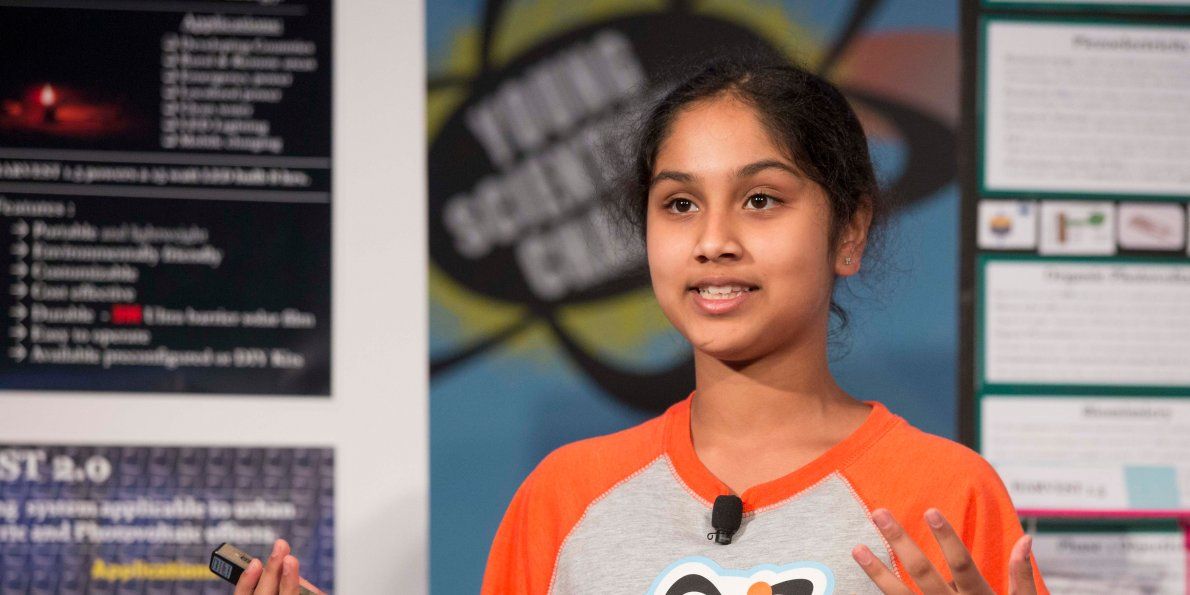Archive for the ‘solar power’ category: Page 127
The sun provides more than enough energy in just one hour to supply our planet’s energy needs for an entire year. Your home can capture this free, abundant energy source through rooftop solar tiles, turning sunlight into electricity for immediate use or storage in a Powerwall battery.
Oct 22, 2016
This brilliant 13-year-old figured out how to make clean energy using a device that costs $5
Posted by Shane Hinshaw in categories: education, solar power, sustainability
Maanasa Mendu thinks she’s cracked the code on how to make wind and solar energy affordable.
On Tuesday, Mendu, a 13-year-old from Ohio, won the grand prize in the Discovery Education 3M Young Scientist Challenge for her work in creating a cost-effective “solar leaves” design to create energy. In addition to winning the title of “America’s Top Young Scientist,” she gets $25,000 for her achievement.
The leaves, designed to help developing areas in need of cheaper power sources, cost roughly $5 to make.
Oct 20, 2016
New perovskite solar cell design could outperform existing commercial technologies
Posted by Shane Hinshaw in categories: engineering, solar power, sustainability
A new design for solar cells that uses inexpensive, commonly available materials could rival and even outperform conventional cells made of silicon.
Writing in the Oct. 21 edition of Science, researchers from Stanford and Oxford describe using tin and other abundant elements to create novel forms of perovskite — a photovoltaic crystalline material that’s thinner, more flexible and easier to manufacture than silicon crystals.
“Perovskite semiconductors have shown great promise for making high-efficiency solar cells at low cost,” said study co-author Michael McGehee, a professor of materials science and engineering at Stanford. “We have designed a robust, all-perovskite device that converts sunlight into electricity with an efficiency of 20.3 percent, a rate comparable to silicon solar cells on the market today.”
Oct 15, 2016
IEEE Reboots, Scans for Future Architectures
Posted by Karen Hurst in categories: computing, information science, quantum physics, solar power, sustainability
If there is any organization on the planet that has had a closer view of the coming demise of Moore’s Law, it is the Institute of Electrical and Electronics Engineers (IEEE). Since its inception in the 1960s, the wide range of industry professionals have been able to trace a steady trajectory for semiconductors, but given the limitations ahead, it is time to look to a new path—or several forks, to be more accurate.
This realization about the state of computing for the next decade and beyond has spurred action from a subgroup, led by Georgia Tech professor Tom Conte and superconducting electronics researcher, Elie Track called “Rebooting Computing,” which produces reports based on invite-only deep dives on a wide range of post-Moore’s Law technologies, many of which were cited here this week via Europe’s effort to pinpoint future post-exascale architectures. The Rebooting Computing effort is opening its doors next week for a wider-reaching, open forum in San Diego to bring together new ideas in novel architectures and modes of computing as well as on the applications and algorithm development fronts.
According to co-chair of the Rebooting Computing effort, Elie Track, a former Yale physicist who has turned his superconducting circuits work toward high efficiency solar cells in his role at startup Nvizix, Moore’s Law is unquestionably dead. “There is no known technology that can keep packing more density and features into a given space and further, the real issue is power dissipation. We just cannot keep reducing things further; a fresh perspective is needed.” The problem with gaining that view, however, is that for now it means taking a broad, sweeping look across many emerging areas; from quantum and neuromorphic devices, approximate computing, and a wide range of other technologies. “It might seem frustrating that this is general, but there is no clear way forward yet. What we all agree on is that we need exponential growth in computing engines.”
Continue reading “IEEE Reboots, Scans for Future Architectures” »
Oct 15, 2016
Los Alamos research team develops new quantum dot solar procedures
Posted by Karen Hurst in categories: internet, quantum physics, solar power, sustainability
Los Alamos is the 1st place where QC Internet was launched.
A research team from Los Alamos National Laboratory published a paper in the journal Nature Energy this week that demonstrates an effective method for scaling up quantum dot solar power technology from production models to full-sized windows that could power a building.
“We are developing solar concentrators that will harvest sunlight from building windows and turn it into electricity, using quantum-dot based luminescent solar concentrators,” lead scientist and leader of the Los Alamos Center for Advanced Solar Photophysics (CASP) Victor Klimov said.
Continue reading “Los Alamos research team develops new quantum dot solar procedures” »
Oct 6, 2016
Robots will build spacecraft in orbit
Posted by Klaus Baldauf in categories: robotics/AI, satellites, solar power, sustainability
Executive Editor
Oct 5, 2016
‘Smart clothing’ could someday power cell phones with the sun’s rays
Posted by Bryan Gatton in categories: mobile phones, solar power, sustainability
Batteries in smart phones and other portable electronics often die at inopportune times. Carrying a spare battery is one solution. As an alternative, researchers have tried to create fibers to incorporate in clothing that would power these devices. However, many of these fibers can’t withstand clothing manufacturing, especially weaving and cutting.
Now, in the journal ACS Nano, scientists report the first fibers suitable for weaving into tailorable textiles that can capture and release solar energy.
To collect solar power, Wenjie Mai, Xing Fan and colleagues created two different types of fibers. One contained titanium or a manganese-coated polymer along with zinc oxide, a dye and an electrolyte. These fibers were then interlaced with copper-coated polymer wires to create the solar cell section of the textile. To store power, the researchers developed a second type of fiber. This one was made of titanium, titanium nitride, a thin carbon shell to prevent oxidation and an electrolyte. These fibers were woven with cotton yarn.
Sep 30, 2016
Motion-directed robots on a micro scale
Posted by Karen Hurst in categories: biotech/medical, robotics/AI, solar power, sustainability
Phototactic behaviour directs some bacteria towards light and others into darkness: This enables them to utilize solar energy as efficiently as possible for their metabolism, or, otherwise, protects them from excessive light intensity. A team of researchers headed by Clemens Bechinger from the Max Planck Institute for Intelligent Systems and the University of Stuttgart, as well as colleagues from the University of Düsseldorf have now found a surprisingly simple way to direct synthetic microswimmers towards light or darkness. Their findings could eventually lead to minuscule robots that seek out and treat lesions in the human body.
Sep 24, 2016
HOIP’s ~ Columbia Chemists Find Key to Manufacturing More Efficient Solar Cells ~ Is this the Future of Solar?
Posted by Karen Hurst in categories: nanotechnology, policy, solar power, sustainability
In a discovery that could have profound implications for future energy policy, Columbia scientists have demonstrated it is possible to manufacture solar cells that are far more efficient than existing silicon energy cells by using a new kind of material, a development that could help reduce fossil fuel consumption.
The team, led by Xiaoyang Zhu, a professor of Chemistry at Columbia University, focused its efforts on a new class of solar cell ingredients known as Hybrid Organic Inorganic Perovskites (HOIPs).
Their results, reported in the prestigious journal Science, also explain why these new materials are so much more efficient than traditional solar cells—solving a mystery that will likely prompt scientists and engineers to begin inventing new solar materials with similar properties in the years ahead.


















